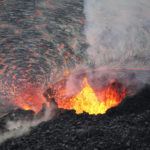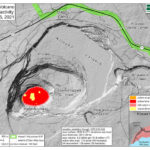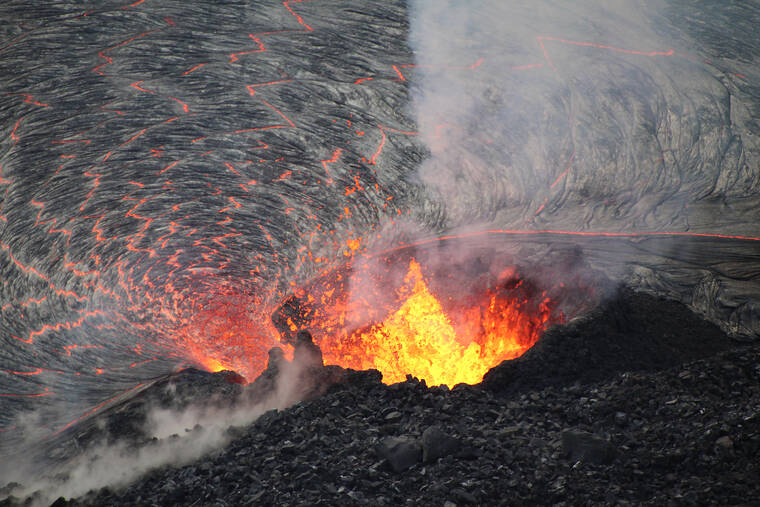Kilauea volcano’s summit lava lake continued to rise Wednesday, one week after the start of the most recent eruption within Halema‘uma‘u crater.
The Hawaiian Volcano Observatory reported Wednesday that lava continued to erupt from two vents; one along the floor and one in the western wall of Halema‘uma‘u crater feeding a lava lake that rose by 7 feet within the preceding 24 hours.
Since the start of the eruption about 3:20 p.m. Sept. 29, the lava lake has rose to 102 feet. The total thickness of lava filling Halema‘uma‘u was 840 feet Wednesday with a lake surface elevation of approximately 2,539 feet above sea level. Due to the location of vents feeding lava to the lake, its surface is not even with the west and south ends 3 feet to 7 feet higher than the north and east ends.
Meanwhile, the observatory said that volcanic gas emission rates remained elevated Wednesday. Sulfur dioxide (SO2) emission rates were measured at 6,000 tons per day on Tuesday, down from 7,000 tons to 9,000 tons per day as of Monday. The rate reached 85,000 tons per day at the start of the eruption.
Seismicity also remained elevated, but stable. Summit tiltmeters continue to record deflationary tilt.
No unusual activity has been noted in the Kilauea East Rift Zone, the observatory said. However, ground deformation motion suggests that the upper East Rift Zone — between the summit and Pu‘u ‘O‘o — has been steadily refilling with magma over the past year.
Also, the observatory said a magnitude-4.6 earthquake that struck east-northeast of Pahala Tuesday night appeared to have no observable impact on Mauna Loa or Kilauea.
The earthquake was recorded at 8:37 p.m. about 5 miles east-northeast of Pahala at a depth of 20 mils. More than 200 felt reports to the USGS “Did you feel it?” website had come in within an hour of the quake.
“This earthquake is part of the ongoing seismic swarm under the Pahala area, which started in August 2019. Webcams and other data streams show no impact on the ongoing eruption at Kilauea. Please be aware that aftershocks are possible and may be felt,” HVO Scientist-in-Charge Ken Hon said. Alert levels remained unchanged for both volcanoes.
Earthquakes in this swarm occur beneath Kilauea’s lower Southwest Rift Zone, beneath the town of Pahala and in an area extending about 6 miles offshore. Most of the earthquakes occur at depths of 15 miles to 25 miles. Earthquakes in this region have been observed at least as far back as the 1960s.
Prior the current eruption that commenced Sept. 29, Kilauea’s most recent eruption occurred between December 2020 and May. The last major eruption occurred in 2018, destroying hundreds of homes and displacing thousands of residents. Since 1952, Kilauea has now erupted 35 times.









